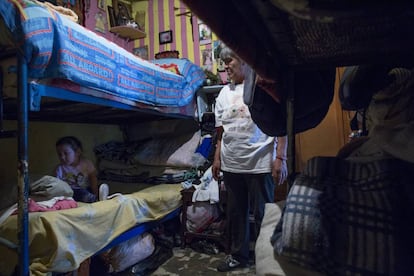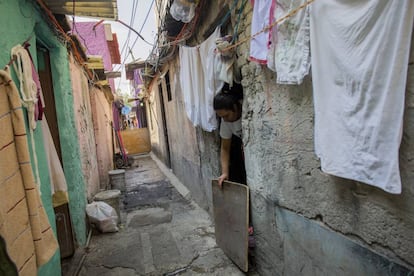A tight spot for the 34 million Mexicans living in micro-apartments
Mexico’s persistent housing crisis has pushed millions to find refuge in tiny shanty homes

Sitting at a small table in her makeshift abode in La Cuesta in Mexico City, Patricia Santiago, 30, explains how the shanty town has spread since 2000 and how it is impossible to get running water or proper drainage installed.
“There are pipelines from Pemex [Mexican oil company] running beneath us and we are told that it is too risky to dig,” she says.
Her home is in Ecatepec, Mexico City’s largest district. In La Cuesta, 130 families are scattered between 80 homes that are built on rocky ground with no available infrastructure. La Cuesta is classed by the authorities as irregular, falling as it does outside of planned urban development. Its growth and that of slums like it is due to the fact that low-income families cannot afford the prices that are being asked in the official property market.
There is a permanent and accumulative housing crisis Housing Institute for Mexico City
The houses in La Cuesta are built by the families themselves. According to a government report, “The use of certain materials and the way they are put together could be a health and safety risk while there is also poor administration of space.”
Patricia, her husband and their two small children live with their grandparents, Patricia’s sister, her sister’s husband and six-year-old son in a house consisting of two rooms, each measuring around 12 m2. In the first room, which has been fashioned from planks and covered with painted white cardboard, there is a table with a couple of chairs and some basic household appliances. In the corner, there is a bed and some curtains that are tied back but drawn at nighttime to afford some privacy. In the other room, there are two beds, also separated by curtains, shared by the two sisters, their husbands and children.
“It’s hard because every family wants space and privacy,” says Patricia. “Especially when the children get bigger.”

The living conditions of this family are far from exceptional. Around 34 million Mexicans live more than two to a room in houses built from poor materials such as cardboard and reeds, according to a report from the Center of Investigation and Documentation of Housing and the Federal Mortgage Society published in 2016. The worst examples are in the regions of Veracruz, Chiapas, Mexico State, Oaxaca and Baja California.
Despite the fact that the Mexican constitution incorporated a clause more than 30 years ago stipulating the right of each citizen to a decent home, property continues to be viewed as a commodity. But Daniel Rodríguez Velázquez, an expert in regional development, explains, “In a poor country, the concept doesn’t work because we don’t have high incomes or stable employment.”
Mexico City
Since Juana Arce has spent her entire life living in a confined space, it scarcely occurs to her anymore to wonder what it would be like to live in more than 16m2. Her home consists of two rooms in a narrow alley in the Miguel Hidalgo district of Mexico City. Once just planks, the walls are now made of brick. The dirt floor has been covered by cement through a federal government program. The roof is made from asbestos and scraps of tarpaulin left over from electoral campaigns. Juana carries out her daily chores in two rooms measuring 12 m2 with her husband, three children and two grandchildren. This is where they eat and watch TV and sleep. At night they all pile into one room where there is one double bed and a bunk.
“What can we do? This is the hand we’ve been dealt,” says the 63 year old who looks every inch her age. Her husband José Manuel Ortiz looks away shyly and explains that he has no steady job because companies don’t employ older men. He used to work as a chauffeur and now he does small jobs with mechanics and blacksmithing. “Of course we would like to make the house bigger and be more comfortable but how can we do that when we scarcely have enough money for food?” says Juana.
“Before it was even smaller and made from cardboard,” says José. “If we support a certain party during electoral campaigns, they give us paint or planks and that is how we have managed to improve it.”
What can we do? This is the hand we’ve been dealt Juana Arce
Juana inherited the shack from her mother who came here more than 50 years ago. When Juana and José were married, they moved in. What they moved in to was a room built from waste in a gloomy alley, which they shared with the rest of the family. Then came children and debt and the dream of living independently faded. But with time, electricity and tarmac arrived. “At least we don’t pay rent here,” says one of the sons. “If you go some blocks from here, they are paying rents worth thousands of pesos.”
San Juanico street contrasts sharply with the wide avenues of much of Miguel Hidalgo. Just three kilometers away is Polanco, one of the most exclusive neighborhoods in the city furnished with foreign embassies and designer shops. Miguel Hidalgo is one of the areas with the highest human development index in the country, according to the UN.
But this is a world away from Juana and José and those like them living in an eternal housing crisis.
The problems fueling the crisis are manifold. For one, low-income households have little access to loans, according to the Group of Economists and Associates (GEA). Besides, the cost of almost all property in the capital is high and there is little in the way of social housing. Loans available to low income families are usually outside the capital, given that housing is less expensive in nearby states. “This means that there is a permanent and accumulative housing crisis,” according to analysis issued by the Housing Institute for Mexico City.
The consequences
A large number of people living in small spaces can led to academic failure, child abuse, stress, tension and depression. The lack of room also fosters illness and mental health disorders.
“The space to eat and be intimate and to rest is so small that people are living on top of one another,” says Rodríguez Velázquez. “And that creates conflict.”
Exacerbating the conflict is commuting time. “There are people who spend two or three hours getting to the center to work or school,” he adds. “After spending five hours traveling, they get home tense and tired and with little desire to share space.”
English version by Heather Galloway.
Tu suscripción se está usando en otro dispositivo
¿Quieres añadir otro usuario a tu suscripción?
Si continúas leyendo en este dispositivo, no se podrá leer en el otro.
FlechaTu suscripción se está usando en otro dispositivo y solo puedes acceder a EL PAÍS desde un dispositivo a la vez.
Si quieres compartir tu cuenta, cambia tu suscripción a la modalidad Premium, así podrás añadir otro usuario. Cada uno accederá con su propia cuenta de email, lo que os permitirá personalizar vuestra experiencia en EL PAÍS.
¿Tienes una suscripción de empresa? Accede aquí para contratar más cuentas.
En el caso de no saber quién está usando tu cuenta, te recomendamos cambiar tu contraseña aquí.
Si decides continuar compartiendo tu cuenta, este mensaje se mostrará en tu dispositivo y en el de la otra persona que está usando tu cuenta de forma indefinida, afectando a tu experiencia de lectura. Puedes consultar aquí los términos y condiciones de la suscripción digital.
More information
Archived In
Últimas noticias
Trump claims peace in Ukraine is near, but Moscow suggests otherwise
A survivor’s account of the Interoceanic Train accident: ‘We were scared because of the speed on the curve’
The Interoceanic Train, the Mexican alternative to the Panama Canal
What is known about the Interoceanic Train derailment in Oaxaca
Most viewed
- Oona Chaplin: ‘I told James Cameron that I was living in a treehouse and starting a permaculture project with a friend’
- Reinhard Genzel, Nobel laureate in physics: ‘One-minute videos will never give you the truth’
- Why the price of coffee has skyrocketed: from Brazilian plantations to specialty coffee houses
- Pablo Escobar’s hippos: A serious environmental problem, 40 years on
- Chevy Chase, the beloved comedian who was a monster off camera: ‘Not everyone hated him, just the people who’ve worked with him’










































